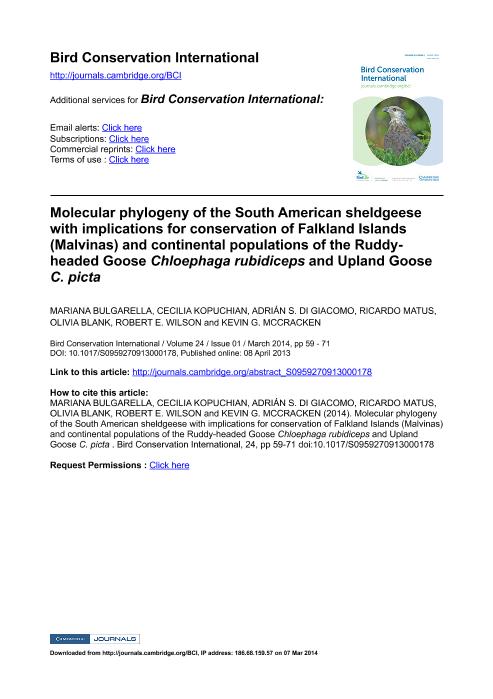Mostrar el registro sencillo del ítem
dc.contributor.author
Bulgarella, Mariana

dc.contributor.author
Kopuchian, Cecilia

dc.contributor.author
Di Giacomo, Adrian Santiago

dc.contributor.author
Matus, Ricardo
dc.contributor.author
Blank, Viviana Claudia

dc.contributor.author
Wilson, Robert E.
dc.contributor.author
McCracken, Kevin G.
dc.date.available
2017-10-02T19:07:07Z
dc.date.issued
2014-03
dc.identifier.citation
Bulgarella, Mariana; Kopuchian, Cecilia; Di Giacomo, Adrian Santiago; Matus, Ricardo; Blank, Viviana Claudia; et al.; Molecular phylogeny of the South American sheldgeese with implications for conservation of Falkland Islands (Malvinas) and continental populations of the Ruddy-headed Goose Chloephaga rubidiceps and Upland Goose C. picta; Cambridge University Press; Bird Conservation International; 24; 1; 3-2014; 59-71
dc.identifier.issn
0959-2709
dc.identifier.uri
http://hdl.handle.net/11336/25659
dc.description.abstract
Sheldgeese of the genus Chloephaga are waterfowl (Anatidae) endemic to mainland South America and the Falkland Islands (Malvinas). Continental populations of three species C. picta, C. poliocephala, and C. rubidiceps breed in Patagonia and Tierra del Fuego and migrate northwards to winter in central Argentina and Chile. These continental populations have declined by > 50% in the past 30 years due to direct hunting to control crop damage and by the introduction of the grey fox Dusicyon griseus to their breeding grounds in Tierra del Fuego. The continental population of C. rubidiceps is critically endangered, estimated to be < 1,000 individuals. While no historic population size estimates exist for C. rubidiceps in its wintering grounds, the breeding population in Tierra del Fuego was estimated to number several thousand individuals in the 1950s. In contrast, the C. rubidiceps population in the Falkland Islands (Malvinas) is non-migratory and stable with > 42,000 individuals, as is the Falkland Islands (Malvinas) population of C. picta leucoptera with > 138,000 individuals. Here we use sequence data from the mitochondrial DNA control region to quantify genetic divergence between insular and continental populations of these two species of sheldgeese. Chloephaga rubidiceps and C. picta showed significant intraspecific differentiation of 1.0% and 0.6%, respectively. In both cases, mainland and insular populations were reciprocally monophyletic and did not share mtDNA haplotypes. These results suggest that the insular and continental populations of C. rubidiceps and C. picta are genetically distinct and that female-mediated gene flow is restricted. We recommend a reevaluation of the threat category status of the continental C. rubidiceps population, under IUCN guidelines. It is necessary to implement urgent actions for the conservation of this critically endangered population.
dc.format
application/pdf
dc.language.iso
eng
dc.publisher
Cambridge University Press

dc.rights
info:eu-repo/semantics/openAccess
dc.rights.uri
https://creativecommons.org/licenses/by-nc-sa/2.5/ar/
dc.subject
Chloephaga
dc.subject
Conservation
dc.subject
Malvinas Islands
dc.subject
Phylogenetics
dc.subject.classification
Bioquímica y Biología Molecular

dc.subject.classification
Ciencias Biológicas

dc.subject.classification
CIENCIAS NATURALES Y EXACTAS

dc.subject.classification
Bioquímica y Biología Molecular

dc.subject.classification
Ciencias Biológicas

dc.subject.classification
CIENCIAS NATURALES Y EXACTAS

dc.title
Molecular phylogeny of the South American sheldgeese with implications for conservation of Falkland Islands (Malvinas) and continental populations of the Ruddy-headed Goose Chloephaga rubidiceps and Upland Goose C. picta
dc.type
info:eu-repo/semantics/article
dc.type
info:ar-repo/semantics/artículo
dc.type
info:eu-repo/semantics/publishedVersion
dc.date.updated
2017-09-19T18:24:50Z
dc.journal.volume
24
dc.journal.number
1
dc.journal.pagination
59-71
dc.journal.pais
Reino Unido

dc.journal.ciudad
Cambridge
dc.description.fil
Fil: Bulgarella, Mariana. Massey University; Nueva Zelanda
dc.description.fil
Fil: Kopuchian, Cecilia. Consejo Nacional de Investigaciones Científicas y Técnicas. Oficina de Coordinación Administrativa Parque Centenario. Museo Argentino de Ciencias Naturales "Bernardino Rivadavia"; Argentina
dc.description.fil
Fil: Di Giacomo, Adrian Santiago. Consejo Nacional de Investigaciones Científicas y Técnicas. Oficina de Coordinación Administrativa Ciudad Universitaria. Instituto de Ecología, Genética y Evolución de Buenos Aires. Universidad de Buenos Aires. Facultad de Ciencias Exactas y Naturales. Instituto de Ecología, Genética y Evolución de Buenos Aires; Argentina
dc.description.fil
Fil: Matus, Ricardo. Centro de Rehabilitación Leñadura; Chile
dc.description.fil
Fil: Blank, Viviana Claudia. Centro de Rehabilitación Leñadura; Chile
dc.description.fil
Fil: Wilson, Robert E.. University of Alaska Fairbanks; Estados Unidos
dc.description.fil
Fil: McCracken, Kevin G.. University of Alaska Fairbanks; Estados Unidos
dc.journal.title
Bird Conservation International

dc.relation.alternativeid
info:eu-repo/semantics/altIdentifier/url/https://www.cambridge.org/core/journals/bird-conservation-international/article/molecular-phylogeny-of-the-south-american-sheldgeese-with-implications-for-conservation-of-falkland-islands-malvinas-and-continental-populations-of-the-ruddyheaded-goose-chloephaga-rubidiceps-and-upland-goose-c-picta/000D3885CC8CE57B8CCB485603E4B814
dc.relation.alternativeid
info:eu-repo/semantics/altIdentifier/doi/https://doi.org/10.1017/S0959270913000178
Archivos asociados
